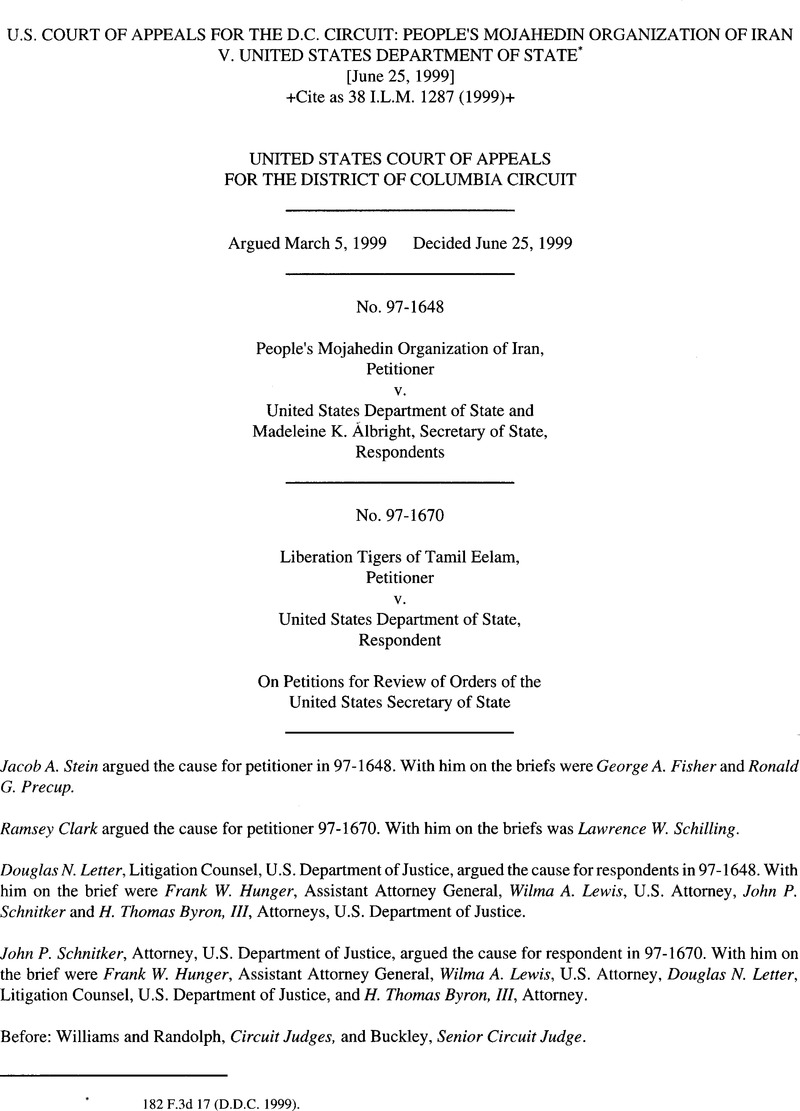No CrossRef data available.
Article contents
U.S. Court of Appeals for the d.c. Circuit: People's Mojahedin Organization of Iran v. United States Department of State
Published online by Cambridge University Press: 27 February 2017
Abstract

- Type
- Judicial and Similar Proceedings
- Information
- Copyright
- Copyright © American Society of International Law 1999
References
* 182F.3dl7(D.D.C. 1999).
1 Because these separate petitions involve the same statute and similar claims, we decide both in a single opinion.
2 All quotations in this part A are from the public version of the administrative record.
3 According to 62 Fed. Reg. at 52,650, the People's Mojahedin Organization of Iran is also known as the Mujahedin-e Khalq, the MEK, the MKO, the PMOI, the Organization of the People's Holy Warriors of Iran and the Sazeman-e Mujahedin-e Khalq-e Iran.
4 Terrorist activity is defined as any activity which is:
unlawful… where it is committed (or which, if committed in the United States, would be unlawful under [state or federal law]), and which involves any of the following: (I) The hijacking or sabotage of any conveyance (including an aircraft, vessel, or vehicle). (II) The seizing or detaining, and threatening to kill, injure, or continue to detain, another individual in order to compel a third person (including a governmental organization) to do or abstain from doing any act as an explicit or implicit condition for the release of the individual seized or detained. (III) A violent attack upon an internationally protected person … or upon the liberty of such a person.
(IV) An assassination.
(V) The use of any-
(a) biological agent, chemical agent, or nuclear weapon or device, or
(b) explosive or firearm (other than for mere personal monetary gain), with intent to endanger, directly or indirectly, the safety of one or more individuals or to cause substantial damage to property.
(VI)A threat, attempt, or conspiracy to do any of the foregoing.8 U.S.C. § 1182(a)(3)(B)(ii).
5 The statute requires the Secretary to notify certain members of the House and Senate before making a designation, but she need not notify the organizations being considered for designation, nor give them an opportunity to be heard. See 8 U.S.C. § 1189(a)(2)(A).
6 Because the issue is not before us, we do not decide whether § 1189 deprives those in the United States of some constitutional right if they are members of, or wish to donate money to, an organization designated by the Secretary.
7 In cases on appeal from the district court, we are to review “judgments, not opinions.” Chevron U.S.A. v. Natural Resources Defense Council, 467 U.S. 837, 842 (1984). Orders issued by agencies are treated differently. In administrative law, we do not sustain a “right-result, wrong-reason” decision of an agency. We send the case back to the agency so that it may fix its reasoning or change its result. SEC v. Chenery Corp., 318 U.S. 80, 88 (1942), explains the difference.
8 Section 1189(b)(3), although generally parroting the language of the Administrative Procedure Act, modified the “substantial evidence” standard of 5 U.S.C. § 706(2)(E) to say instead “substantial support.” Perhaps this was in recognition of the decision of- this court that whenever a statute requires the agency action to be supported by “substantial evidence” — a term of art in administrative law — there must be “some sort of adversary, adjudicative-type procedures” before the agency. Mobil Oil Corp. v. FPC, 483 F.2d 1238, 1259 (D.C. Cir. 1973).


